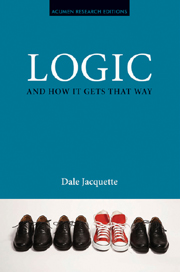Book contents
- Frontmatter
- Contents
- Preface
- Introduction: Logic, philosophy, analysis
- 1 Logical form
- 2 Monkey raisins
- 3 The secret life of truth-functions
- 4 Reference and identity
- 5 Intensional versus extensional logic and semantics
- 6 Truth
- 7 Logical and semantic paradoxes
- Conclusion: Moral lessons of logic
- Notes
- References
- Index
Introduction: Logic, philosophy, analysis
- Frontmatter
- Contents
- Preface
- Introduction: Logic, philosophy, analysis
- 1 Logical form
- 2 Monkey raisins
- 3 The secret life of truth-functions
- 4 Reference and identity
- 5 Intensional versus extensional logic and semantics
- 6 Truth
- 7 Logical and semantic paradoxes
- Conclusion: Moral lessons of logic
- Notes
- References
- Index
Summary
What is logic, and to paraphrase American novelist Henry Miller on a rather different topic, how does it get that way? These are questions that we can answer at length only as we proceed to investigate a selection of problems that have shaped the study of logic over the course especially of the last one hundred and fifty years. Miller, who inspires the present book's title, offers the following reflections in his remarkable essay, “Money and How it Gets That Way”:
To return, therefore, to the axiomatic: Money has no life of its own except as money. To the man in the street, unaccustomed to thinking of money in abstract terms, this obvious truism may smack of casuistry. Yet nothing could be more simple and consistent than this reduction to tautology, since money in any period whatever of man's history has, like life itself, never been found to represent the absence of money. Money is, and whatever form or shape it may assume it is never more nor less than money. To inquire, therefore, how it comes about that money has become what it now is, is as idle as to inquire what makes evolution … And yet a glance at any of the views now current in the upper realms of finance would tend to convince us that the sole effort of man from prehistoric times on has been to prove that money is not money at all but something which passes for something else, such as specie [coins], for example.[…]
- Type
- Chapter
- Information
- Logic and How it Gets That Way , pp. 1 - 6Publisher: Acumen PublishingPrint publication year: 2010



